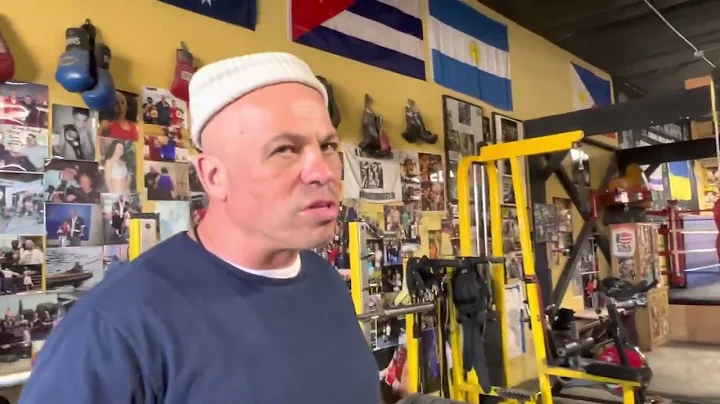Robert I Kaminsky
age ~83
from Houston, TX
- Also known as:
-
- Robert Dr Kaminsky
- Robert Isadore Kaminsky
- Jan Kaminsky
- Rob I Kaminsky
- Bob I Kaminsky
- Robert Marshall
- Kirk Kaminsky
- Rober Marshall
- Phone and address:
-
3822 Purdue St, Houston, TX 77005
(713)7750875
Robert Kaminsky Phones & Addresses
- 3822 Purdue St, Houston, TX 77005 • (713)7750875
- 2351 Underwood St, Houston, TX 77030 • (713)6619400 • (713)8382240
- 2342 Underwood St, Houston, TX 77030
- 1315 St Joseph Pkwy, Houston, TX 77002 • (713)6523118 • (713)6593477
- Solana Beach, CA
- Melrose Park, IL
- 2351 Underwood St, Houston, TX 77030 • (713)4715907
Work
-
Position:Executive, Administrative, and Managerial
Education
-
Degree:Graduate or professional degree
Us Patents
-
Methods Of Treating A Subterranean Formation To Convert Organic Matter Into Producible Hydrocarbons
view source -
US Patent:7331385, Feb 19, 2008
-
Filed:Apr 14, 2004
-
Appl. No.:10/558068
-
Inventors:William A. Symington - Houston TX, US
Michele M. Thomas - Houston TX, US
Quinn R. Passey - Kingwood TX, US
Abdel Wadood M. El-Rabaa - Houston TX, US
Jeff H. Moss - The Woodlands TX, US
Robert D. Kaminsky - Houston TX, US -
Assignee:ExxonMobil Upstream Research Company - Houston TX
-
International Classification:E21B 43/00
-
US Classification:166248, 1663081
-
Abstract:Methods are provided that include the steps of providing wells in a formation, establishing one or more fractures () in the formation, such that each fracture intersects at least one of the wells (), placing electrically conductive material in the fractures, and generating electric current through the fractures and through the material such that sufficient heat () is generated by electrical resistivity within the material to pyrolyze organic matter in the formation into producible hydrocarbons.
-
Hydrocarbon Recovery From Impermeable Oil Shales
view source -
US Patent:7441603, Oct 28, 2008
-
Filed:Jul 30, 2004
-
Appl. No.:10/577332
-
Inventors:Robert D. Kaminsky - Houston TX, US
William A. Symington - Houston TX, US -
Assignee:ExxonMobil Upstream Research Company - Houston TX
-
International Classification:E21B 43/267
E21B 43/40
E21B 43/17
E21B 43/24 -
US Classification:1663081, 166266, 166267, 1662722, 166303, 166371
-
Abstract:An economic method for in situ maturing and production of oil shale or other deep-lying, impermeable resources containing immobile hydrocarbons. Vertical fractures are created using horizontal or vertical wells. The same or other wells are used to inject pressurized fluids heated to less than approximately 370 C. , and to return the cooled fluid for reheating and recycling. The heat transferred to the oil shale gradually matures the kerogen to oil and gas as the temperature in the shale is brought up, and also promotes permeability within the shale in the form of small fractures sufficient to allow the shale to flow into the well fractures where the product is collected commingled with the heating fluid and separated out before the heating fluid is recycled.
-
Method Of Developing Subsurface Freeze Zone
view source -
US Patent:7516785, Apr 14, 2009
-
Filed:Oct 10, 2007
-
Appl. No.:11/973764
-
Inventors:Robert D. Kaminsky - Houston TX, US
-
Assignee:ExxonMobil Upstream Research Company - Houston TX
-
International Classification:E21B 36/00
E21B 43/30
E21B 49/08 -
US Classification:166245, 166 52, 166 57, 1662421, 16625014, 166264, 166302, 405130
-
Abstract:A method for lowering the temperature of a portion of a subsurface formation is provided. Preferably, the formation is an oil shale formation. The method includes the step of injecting a cooling fluid under pressure into a wellbore, with the wellbore having been completed at or below a depth of the subsurface formation. In one embodiment the wellbore has an elongated tubular member for receiving the cooling fluid and for conveying it downhole to the subsurface formation. The wellbore also has an expansion valve in fluid communication with the tubular member through which the cooling fluid flows. The method then includes the steps of injecting a cooling fluid under pressure into the wellbore, and expanding the cooling fluid across the first expansion valve. In this way, the temperature of the cooling fluid is reduced. The temperature of the surrounding formation is likewise reduced through thermal conduction and convection.
-
Method Of Developing A Subsurface Freeze Zone Using Formation Fractures
view source -
US Patent:7516787, Apr 14, 2009
-
Filed:Oct 10, 2007
-
Appl. No.:11/973745
-
Inventors:Robert D. Kaminsky - Houston TX, US
-
Assignee:ExxonMobil Upstream Research Company - Houston TX
-
International Classification:E21B 36/00
E21B 43/26
E21B 43/267
E21B 49/00 -
US Classification:1662501, 166 57, 166270, 166271, 166281, 166302, 1663081, 405130
-
Abstract:A method for lowering the temperature of a portion of a subsurface formation is provided. Preferably, the formation is an oil shale formation. The method includes the step of injecting a cooling fluid under pressure into a wellbore, with the wellbore having been completed at or below a depth of the subsurface formation. The wellbore has an elongated tubular member for receiving the cooling fluid and for conveying it downhole to the subsurface formation. The wellbore also has an expansion valve in fluid communication with the tubular member through which the cooling fluid flows. The method then includes the steps of injecting a cooling fluid under pressure into the wellbore, and expanding the cooling fluid across the first expansion valve. In this way, the temperature of the cooling fluid is reduced. The temperature of the surrounding formation is likewise reduced through thermal conduction and convection.
-
Methods Of Treating A Subterranean Formation To Convert Organic Matter Into Producible Hydrocarbons
view source -
US Patent:7631691, Dec 15, 2009
-
Filed:Jan 25, 2008
-
Appl. No.:12/011456
-
Inventors:William A. Symington - Houston TX, US
Abdel Wadood M El-Rabaa - Houston TX, US
Robert D. Kaminsky - Houston TX, US
William P. Meurer - Pearland TX, US
Quinn Passey - Kingwood TX, US
Michele M. Thomas - Houston TX, US -
Assignee:ExxonMobil Upstream Research Company - Houston TX
-
International Classification:E21B 43/237
-
US Classification:166248, 1663081
-
Abstract:Methods are provided that include the steps of providing wells in a formation, establishing one or more fractures in the formation, such that each fracture intersects at least one of the wells, placing electrically conductive material in the fracture, and applying an electric voltage across the fracture and through the material such that sufficient heat is generated by electrical resistivity within the material to heat and/or pyrolyze organic matter in the formation to form producible hydrocarbons.
-
In Situ Co-Development Of Oil Shale With Mineral Recovery
view source -
US Patent:7644993, Jan 12, 2010
-
Filed:Mar 22, 2007
-
Appl. No.:11/726651
-
Inventors:Robert D. Kaminsky - Houston TX, US
William A. Symington - Houston TX, US
Jesse D. Yeakel - Missouri City TX, US
Michele M. Thomas - Houston TX, US -
Assignee:ExxonMobil Upstream Research Company - Houston TX
-
International Classification:E21B 43/241
-
US Classification:299 5, 166302
-
Abstract:A method of producing hydrocarbon fluids from a subsurface organic-rich rock formation, for example an oil shale formation, in which the oil shale formation contains water-soluble minerals, for example nahcolite, is provided. In one embodiment, the method includes the step of heating the organic-rich rock formation in situ. Optionally, this heating step may be performed prior to any substantial removal of water-soluble minerals from the organic-rich rock formation. In accordance with the method, the heating of the organic-rich rock formation both pyrolyzes at least a portion of the formation hydrocarbons, for example kerogen, to create hydrocarbon fluids, and converts at least a portion of the water-soluble minerals, for example, converts nahcolite to soda ash. Thereafter, the hydrocarbon fluids are produced from the formation.
-
Method Of Developing Subsurface Freeze Zone
view source -
US Patent:7647971, Jan 19, 2010
-
Filed:Dec 23, 2008
-
Appl. No.:12/343109
-
Inventors:Robert D. Kaminsky - Houston TX, US
-
Assignee:ExxonMobil Upstream Research Company - Houston TX
-
International Classification:E21B 36/00
-
US Classification:166302, 166 57, 1662421, 62260, 165 45, 405130
-
Abstract:A method of lowering the temperature of a subsurface formation, e. g. , comprising oil shale, includes injecting a cooling fluid under pressure into a wellbore. The wellbore is completed at or below a depth of the subsurface formation, and the wellbore includes a bore formed through the subsurface formation defining a diameter. The cooling fluid comprises a slurry having particles of frozen material. The cooling fluid is circulated across the formation in order to lower the temperature of at least a portion of the formation to a point that is at or below the freezing point of water.
-
Subsurface Freeze Zone Using Formation Fractures
view source -
US Patent:7647972, Jan 19, 2010
-
Filed:Dec 23, 2008
-
Appl. No.:12/343127
-
Inventors:Robert D. Kaminsky - Houston TX, US
-
Assignee:ExxonMobil Upstream Research Company - Houston TX
-
International Classification:E21B 36/00
E21B 43/26 -
US Classification:166302, 166306, 1663081, 405130
-
Abstract:A method of lowering the temperature of a subsurface formation, e. g. , a subsurface formation including oil shale, includes completing a well having fluid communication with the subsurface formation at a first depth and a second lower depth. A fracturing fluid is injected into the well so as to form a fracture at a depth of the subsurface formation, and thereby provides fluid communication between the first and second depths in the well. A cooling fluid is circulated under pressure through the well and into the fracture so as to cause the cooling fluid to flow from the well, into subsurface formation at the first depth, to the subsurface formation at the second depth, and back into the well, thereby lowering the temperature of the subsurface formation.
Resumes

Senior Research Engineer
view sourceLocation:
Houston, TX
Industry:
Oil & Energy
Work:
Exxonmobil
Senior Research Engineer
Senior Research Engineer

Exotic Dancer
view sourceWork:
Exotic Dancer

Robert Kaminsky
view source
Robert Kaminsky
view source
Robert Kaminsky
view source
Robert Kaminsky
view sourceLocation:
United States

Robert Kaminsky
view sourceLocation:
United States
Medicine Doctors

Dr. Robert I Kaminsky, Houston TX - MD (Doctor of Medicine)
view sourceSpecialties:
Urology
Address:
1315 St Joseph Pkwy, Houston, TX 77002
Certifications:
Urology, 1978
Awards:
Healthgrades Honor Roll
Languages:
English
Education:
Medical School
Baylor College Of Medicine
Medical School
Baylor College Of Med
Medical School
Med Center La New Orleans Lsu
Medical School
Wm Beaumont Army Med Center
Baylor College Of Medicine
Medical School
Baylor College Of Med
Medical School
Med Center La New Orleans Lsu
Medical School
Wm Beaumont Army Med Center

Dr. Robert I Kaminsky, Houston TX - MD (Doctor of Medicine)
view sourceAddress:
2351 Underwood St, Houston, TX 77030
Hospitals:
2351 Underwood St, Houston, TX 77030
Education:
Medical Schools
Baylor University
Graduated: 1968
Baylor University
Graduated: 1968

Robert Philip Kaminsky
view sourceSpecialties:
Obstetrics & Gynecology
Family Medicine
Family Medicine
Education:
Yeshiva University (1966) Internal Medicine
Name / Title
Company / Classification
Phones & Addresses
President
K Motors, Inc
Ret New/Used Automobiles Ret Used Automobiles · Auto Repair
Ret New/Used Automobiles Ret Used Automobiles · Auto Repair
965 Arnele Ave, El Cajon, CA 92020
965 Amele Ave, El Cajon, CA 92020
(619)2703000, (619)5881046, (866)8214241
965 Amele Ave, El Cajon, CA 92020
(619)2703000, (619)5881046, (866)8214241
Director
WASHINGTON ADVISORS GP, LLC
Nonclassifiable Establishments
Nonclassifiable Establishments
4888 Loop Central Dr STE 950, Houston, TX 77081
2351 Underwood Blvd, Houston, TX 77030
2351 Underwood Blvd, Houston, TX 77030
General Partner
DAVE KAMINSKY ET AL INTERESTS, LTD
2417 Maroneal St, Houston, TX 77030
2351 Underwood St, Houston, TX 77030
2351 Underwood St, Houston, TX 77030
General Partner
ROBERT I. KAMINSKY ET AL INTERESTS, LTD
2351 Underwood St, Houston, TX 77030
CINCINNATI RUG ARTISANS LLC
TOYOTA SERVICE CENTER
Car Accessories · Muffler Repair · Car Sales · Auto Repair · Car Tires
Car Accessories · Muffler Repair · Car Sales · Auto Repair · Car Tires
9135 Msn Gorge Rd, Santee, CA 92071
(619)5967700
(619)5967700
Executive
Birth Control Center
Medical Doctor's Office
Medical Doctor's Office
17070 Red Oak Dr, Houston, TX 77090
Director
TREEVILLE PROPERTIES, LLC
Nonresidential Building Operator
Nonresidential Building Operator
1058 Del Norte St, Houston, TX 77018
3749 Wakeforest St, Houston, TX 77098
3749 Wakeforest St, Houston, TX 77098
Myspace
Flickr

Robert Kaminsky
view source
Robert Kaminsky
view source
Robert Kaminsky
view source
Robert Kaminsky
view source
Robert Bj Kaminsky
view source
Robert Kaminsky
view source
Robert Kaminsky
view source
Robert Kaminsky
view sourceClassmates

Concordia University, Edm...
view sourceGraduates:
Robert Kaminsky (2005-2007),
Eric Marsolais (1994-1996),
Peggy Johnson (1975-1977),
Karin Pankow (1985-1987)
Eric Marsolais (1994-1996),
Peggy Johnson (1975-1977),
Karin Pankow (1985-1987)

Snowden High School, Libr...
view sourceGraduates:
Robert Kaminsky (1959-1963),
Mary Kozak (1960-1964),
Pat Midkiff (1957-1961),
Paula Malinowski (1960-1964),
Eleanor Blythe (1950-1954)
Mary Kozak (1960-1964),
Pat Midkiff (1957-1961),
Paula Malinowski (1960-1964),
Eleanor Blythe (1950-1954)

East Coast Aero Tech Scho...
view sourceGraduates:
Bob Kaminsky (1987-1990),
Ronald Giles (1966-1969),
Dwyan Miller (1998-2002),
Walter Nordstrom (1970-1972),
Stephen Wilson (2001-2003)
Ronald Giles (1966-1969),
Dwyan Miller (1998-2002),
Walter Nordstrom (1970-1972),
Stephen Wilson (2001-2003)
Googleplus

Robert Kaminsky

Robert Kaminsky

Robert Kaminsky
Youtube
Get Report for Robert I Kaminsky from Houston, TX, age ~83













